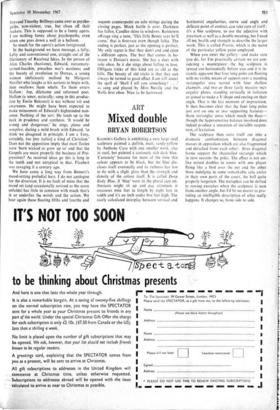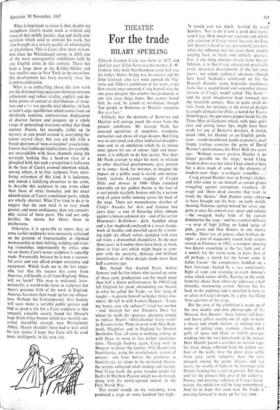Mixed double
ART BRYAN ROBERTSON
Kasmin's Gallery is exhibiting a very large steel sculpture painted a dullish, matt, sandy-yellow by Anthony Caro with one smaller work, also in steel, but painted a curiously rich dark blue. 'Curiously' because for most of the time this colour appears to be black, but the blue dis- closes itself eventually and its richness has less to do with a slight gloss than the strength and density of the colour itself. It is called Deep Body Blue, if 'blue' were in the plural jazz en- thusiasts might sit up and pay attention, it measures nine feet in length by eight feet in width and it's an inch under five feet high. The nicely calculated interplay between vertical and horizontal angularities, curve and angle and delicate point of contact, can take care of itself: it's a fine sculpture, to use the adjective with precision as well as a double meaning, but I need all my health and strength to describe the larger work. This is called Prairie, which is the name of the particular yellow paint employed.
When you enter the gallery—and make sure you do, for I'm practically certain we are con- sidering a masterpiece—the big sculpture is spread out horizontally before you and it is in- stantly apparent that four long poles are floating with no visible means of support over a receding rectangular area scored with four shallow channels, and two or three fairly massive rect- angular plates, standing vertically in isolation or joined to make a V shape and .resting on their angle. That is the last moment of imprecision. It then becomes clear that the four long poles just rest on one or two supporting features— those rectanglar areas which touch the floor— though the hypersensitive balance involved does indeed produce a sensation of invisible suspen- sion, of levitation.
The sculpture then sorts itself out into a dramatic confrontation between diagonal masses in opposition which are also fragmented and detached from each other: three diagonal forms support the channelled rectangle which in turn sustains the poles. The effect is not un- like mixed doubles in tennis with one player flying like a bird over the net and the other three indulging in some remarkable solo antics in their own parts of the court, the ball quite properly forgotten. The metaphor can be shifted to rowing exercises when the sculpture is seen from another angle, but I'd be no nearer to pro- viding an intelligible description of what really happens. It changes so, from side to side.
What is important to stress is that, despite my metaphors, Caro's recent work is without any trace of that mildly jocular, slap and tickle con- notation which used to animate his work, but also brought in a certain quality of whimsicality or playfulness. This is Caro's first show in Lon- don since the Whitechapel survey in 1963, one of the most consequential exhibitions held by any English artist in this century. There has been a large show at the Kriiller-Milller and two smaller ones in New York in the meantime. His development has been masterly since the London celebration.
What is so enthralling about this new work are the disconcerting equations between extreme refinement and robust vitality, explicit and de- finite points of contact or distributions of struc- ture and a flr less specific total identity : in fact, a razor's edge equilibrium which comes from an absolutely concrete, unmysterious deployment of discreet factors and conjures up a whole range of generalised reactions within that fixed context. Prairie, for example, yields up its mystery as you prowl around it, everything be- comes crystal clear, but you are left with a broad spectrum of 'non-associative' associations. I mean that landscape implications, for example, are unavoidable with those channels along the rectangle looking like a head-on view of a' ploughed field, but such a projection is ludicrous in the face of Caro's avowed intention which, among others, is to free sculpture from inter- fering references of this kind. It is ludicrous, and indeed a falsifying disservice to the artist, to describe this sculpture in any terms other than those of strict formality and the exact adumbration of Caro's constituent parts, which are wholly abstract. What I've tried to do is to suggest that the sum total is so very much greater, and more ambiguous, than any conceiv- able recital of these parts. The end not only justifies the means but blows them to smithereens.
Otherwise, it is agreeable to report that, as some earlier sculptures were nervously criticised on the grounds of impracticality or slipshod workmanship in their bolting, welding and rivet- ing (sometimes impertinently by critics who sat on them), Caro's newer sculpture is superbly made. Presumably because he is now a success- ful artist and can afford proper assistance and ,equipment. Which leads me to the less enjoy- able fact that his success has come from America, still hardly at all from England. When will we learn? This man is reckoned, inter- nationally, a world-wide force in sculpture but there's precious little of his work in England. America has more than made up for our obtuse- ness. Perhaps the Contemporary Arts Society will soon make a suitable public gesture and find as good a site for a Caro sculpture as this uniquely valuable society found for Moore's huge Knife-Edge bronze which was recently un- veiled, incredibly enough, near Westminster Abbey. Moore shouldn't have had to wait until his late sixties; I hope that Caro will be used more intelligently in his own city.







































 Previous page
Previous page